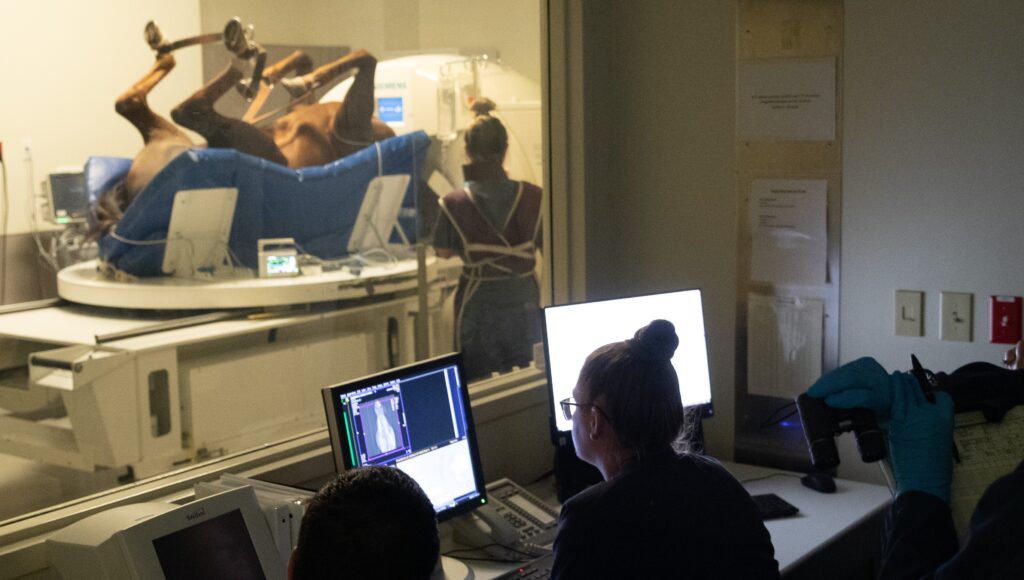Texas A&M School of Veterinary Medicine & Biomedical Sciences Ranks Among World’s Best Veterinary Schools
Story by Rachel Knight, VMBS Communications

The Texas A&M School of Veterinary Medicine & Biomedical Sciences (VMBS) is ranked 11th in the world and 6th in the United States in veterinary science, according to the 2023 Quacquarelli Symonds (QS) World University Rankings by Subject.
Texas A&M is also the most highly ranked among all Southeastern Conference (SEC) universities with veterinary schools.
The VMBS’ 2023 rankings took a large leap up from 2022, when the VMBS was ranked No. 20 worldwide. The annually compiled rankings cover a total of 54 disciplines, grouped into five broad subject areas.
“We are delighted by this recognition, and we are honored to represent Texas A&M University, the Texas A&M System, and the state of Texas in the QS World University Rankings,” said Dr. John August, the Carl B. King Dean of Veterinary Medicine at Texas A&M. “This achievement was made possible by our outstanding faculty, students, and staff who do remarkable work each day at the VMBS to fulfill our teaching, research, and patient care missions. It is always rewarding to see their collective hard work recognized, especially on a global and national scale.”
For more than 100 years, the VMBS has been dedicated to enhancing animal and human health through transformational education, discovery and innovation, patient care, and public service that impact our diverse and evolving world.
Transformational education is at the core of the VMBS’ existence; this is evident in the fact that the VMBS is one of the largest Doctor of Veterinary Medicine (DVM) training programs in the country, with a class size of 180. In addition, the Texas A&M DVM Class of 2023’s North American Veterinary Licensing Examination first-attempt pass rate was 93%, compared to the national average of 79%.
The VMBS’ Veterinary Medical Teaching Hospital (VMTH) provides the capstone educational experience for Texas A&M’s DVM students.
The VMTH has the distinction of being Texas A&M’s largest educational laboratory and the state’s only veterinary medical teaching hospital. DVM students completing their fourth-year clinical rotations through the VMBS see almost 30,000 animal cases annually from across North America and receive training in more than two dozen large and small animal veterinary specialties.
VMBS faculty and students also turn basic science into novel discoveries that set the course for improving human and animal health; publication citations and the h index, which reflects the productivity and impact of a university’s basic science and clinical research activities, were among the criteria assessed in the QS rankings.
“This ranking reflects the high-quality and impact of the translational and basic biomedical research being conducted at our school by our world-class faculty and the students they mentor,” said Dr. Ramesh Vemulapalli, VMBS executive associate dean.
The VMBS’ Research & Graduate Studies Office administers one of the largest graduate programs at a school of veterinary medicine, and veterinary students gain exposure to research through programs such as the Veterinary Medical Scientist Research Training Program and through clinical trials offered within the VMTH.
In addition, through the VMBS’ Veterinary Education, Research, & Outreach (VERO) initiative, housed on the West Texas A&M University campus in Canyon, veterinary students get exposure to large animal and mixed animal medicine through VERO partnerships with Texas’ thriving livestock and food animal industries as well as with rural veterinary practitioners.
The VMBS’ 2+2 DVM program, launched in 2021, offers up to 18 students the opportunity to complete the first two years of their veterinary medical education at VERO before joining their peers in College Station for their third and clinical years. VERO also offers opportunities for DVM students to return to the Texas Panhandle during fourth-year clinical rotations in dairy practice, feedlot medicine/surgery, cow-calf practice, and rural/mixed animal general practice.
QS World University Rankings are used by prospective students to help identify the leading universities in a particular subject. Universities are ranked based on journal article citations and by the results of major global surveys of employers and academics.
###
For more information about the Texas A&M School of Veterinary Medicine & Biomedical Sciences, please visit our website at vetmed.tamu.edu or join us on Facebook, Instagram, and Twitter.
Contact Information: Jennifer Gauntt, Director of VMBS Communications, Texas A&M School of Veterinary Medicine & Biomedical Sciences, jgauntt@cvm.tamu.edu, 979-862-4216


